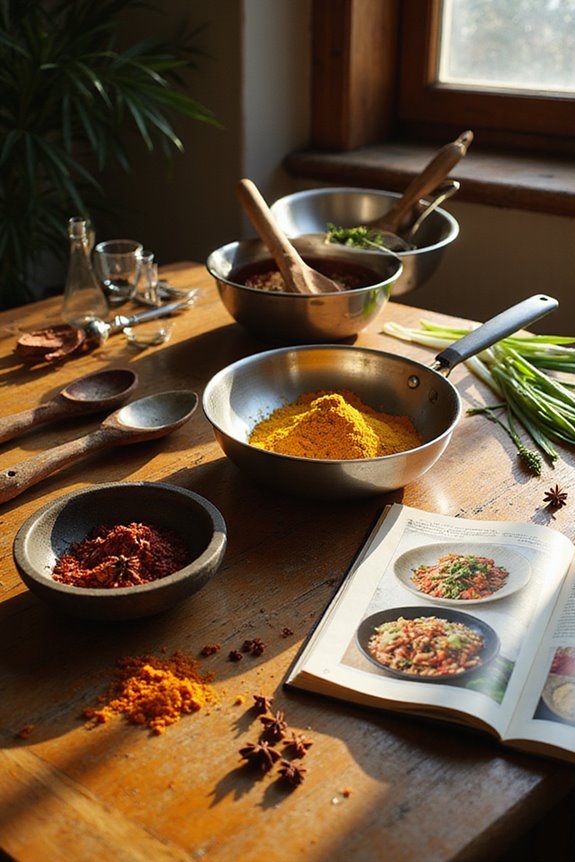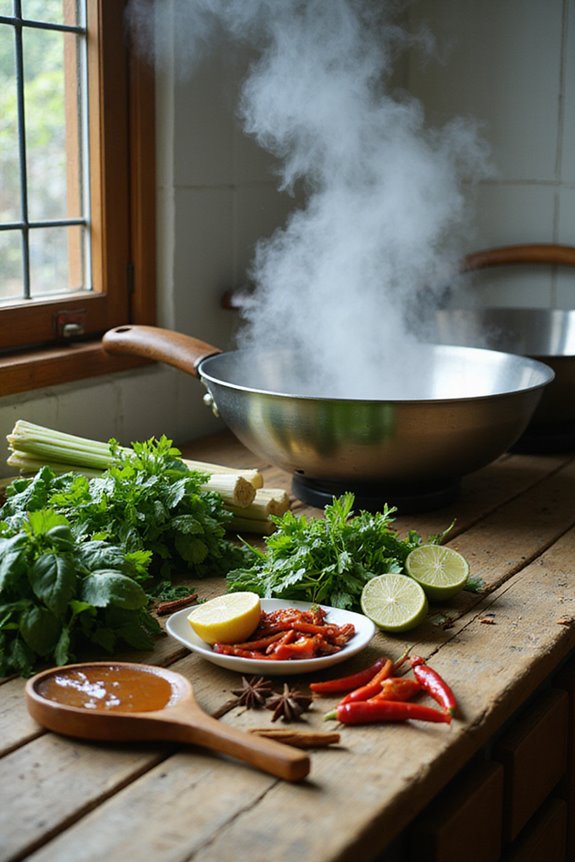When we think of essential Filipino ingredients, a delightful list comes to mind! First, we love our staple base like Jasmine rice and various noodles. Next, umami flavors from fish sauce and bagoong bring magic to our dishes. Don’t forget the zingy vinegars like sukang maasim for that perfect balance! Key veggies like malunggay and ginger add nutrients and flavor. With exciting sauces and sweeteners like calamansi juice, cooking becomes a festive celebration. Stick around; we’ve got more tasty tidbits up our sleeve!
Key Takeaways
- Rice varieties, especially jasmine rice and sweet sticky rice, form the base for many Filipino dishes and desserts.
- Fish sauces and fermented shrimp pastes like bagoong are essential for adding umami and depth to various recipes.
- Vinegars, like sukang maasim and coconut vinegar, are crucial for balancing flavors in dishes such as adobo and paksiw.
- Key vegetables like malunggay, kangkong, and ginger are often used to enhance the nutritional value and flavor of soups and stews.
- Sauces and condiments, including bagoong alamang and calamansi juice, are vital for creating authentic Filipino flavors in meals.
Staple Base Ingredients
When it comes to Filipino cuisine, three magical words come to mind: rice, noodles, and vinegar! These staple base ingredients create delightful dishes that bring us together.
Rice Varieties
- Jasmine rice is our go-to for every meal.
- Sweet sticky rice is perfect for traditional desserts like suman.
Noodle Types
- Pancit is the star here, with varieties like:
- Bihon: thin rice vermicelli
- Sotanghon: mung bean thread noodles
- Canton: wheat-based egg noodles
These ingredients not only fill our bellies but also warm our hearts! Additionally, using multifunctional tools can help us efficiently prepare these staple dishes. So, let’s embrace these essentials in our kitchens and whip up some culinary magic. After all, who doesn’t want to share a delicious meal during the holidays?
Umami and Fermented Flavor Components
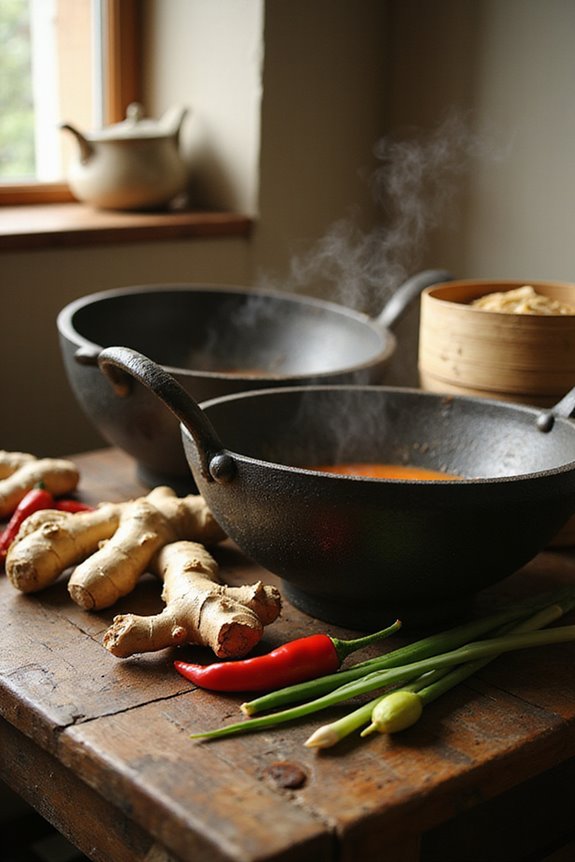
Plunge into the magical world of umami and fermented flavors, where every meal becomes a delightful adventure! Filipino cooking shines bright with our beloved fish sauce varieties, packed with intense umami and salty goodness. Just a splash enhances stews and grilled delights, making each bite unforgettable.
Let’s not forget about our fantastic fermented shrimp pastes, like bagoong. Whether it’s the sweeter bagoong alamang or the pungent bagoong isda, these treasures bring unique flavors to dishes like pinakbet and kare-kare.
We often serve these savory components sparingly, as they deepen flavors without overwhelming. Additionally, using high-quality ingredients, such as organic seasonings, can elevate these flavors even further. So, let’s embrace these umami gems and transform our meals into savory masterpieces that warm the heart and gather family around the table!
Vinegars and Sour Elements
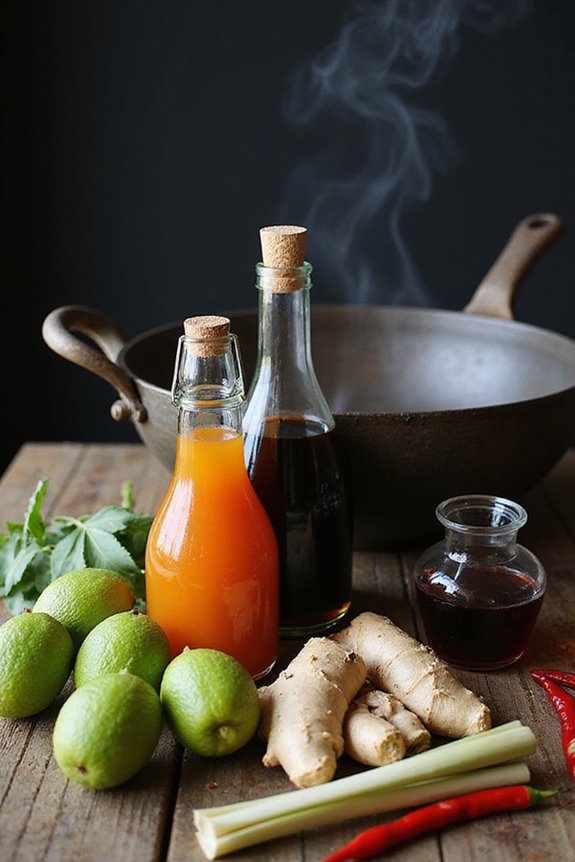
Let’s explore some popular cooking techniques:
- Adobo: Vinegar melds with soy sauce for that perfect balance.
- Paksiw: A stewing method that brings out the rich flavors.
- Sisig: A tangy twist that leaves us wanting more!
Regional preferences matter too! From *sukang maasim* in Metro Manila to coconut vinegar in the south, our diverse home-cooked meals reflect vibrant Filipino culture. These delicious ingredients often provide essential cooking equipment that elevate our culinary experiences. So, let’s celebrate these delightful ingredients!
Key Vegetables and Herbs
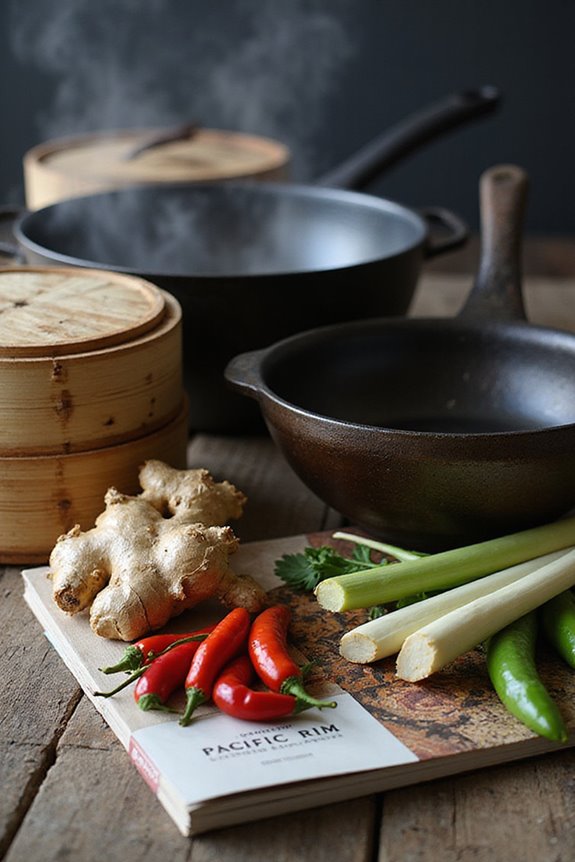
After savoring the tangy delights of our Filipino vinegars, it’s time to brighten our cooking with the stunning array of leafy greens, herbs, and vegetables we cherish. These key vegetables not only elevate our dishes but also offer fantastic benefits!
- Malunggay (Moringa): Perfect in soups, it packs tons of nutrients.
- Kangkong (Water Spinach): Versatile and delicious in stews!
- Ginger: Our go-to for flavor, especially in adobo.
Don’t forget our essential herbs!
- Lemongrass (Tanglad): Adds a magical aroma to chicken tinola.
- Bay Leaves: Simple but boosts flavor!
Incorporating these ingredients can enhance the overall taste and appeal of your meals, as they complement high-quality materials for kitchen tools that elevate cooking experience.
Sauces, Condiments, and Sweeteners
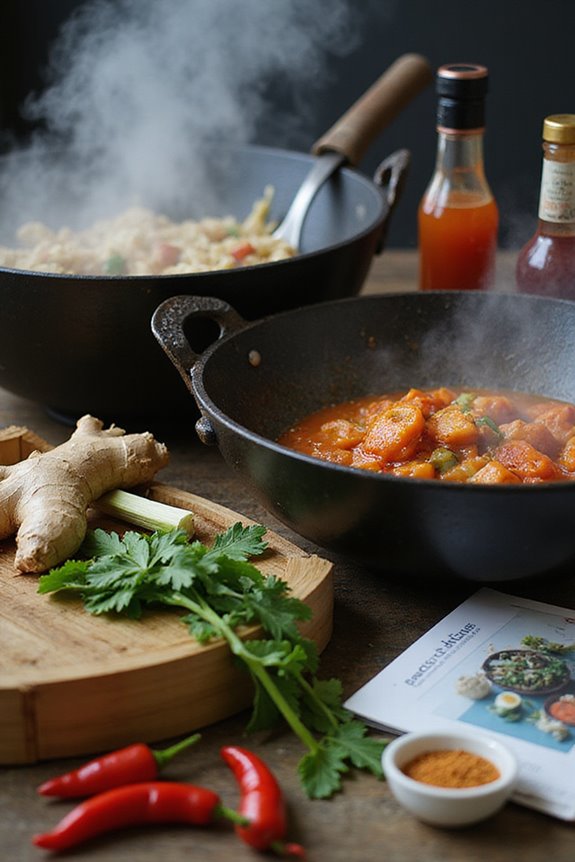
Here are some fabulous condiment pairings to try:
- Bagoong Alamang for an umami punch.
- Calamansi juice brightens your dishes beautifully. Additionally, incorporating sambal spice pastes can elevate flavors with authentic flavor profiles that enhance various dishes, adding an exciting kick to your culinary creations.
With these essentials, we can transform any meal into a culinary celebration. Let’s get cooking and make some magic!
Common Protein and Canned Items
What proteins can we explore to elevate our Filipino dishes? Let’s plunge into the magical world of protein diversity! We love using:
- Pork for its rich flavors in dishes like adobo.
- Chicken, a lean option perfect for Chicken Inasal.
- Fish and seafood, whether fresh or canned, bringing omega-3 goodness.
- Eggs, packed with protein for any meal.
For canned convenience, consider:
- Canned sardines for a quick and tasty meal.
- Canned tuna to jazz up salads.
- Corned beef, a pantry staple, deliciously paired with onions.
Adding to this, proteins like pork and chicken are often featured in traditional Filipino recipes, making them foundational to authentic culinary experiences.
Frequently Asked Questions
What Are Traditional Cooking Methods Used in Filipino Cuisine?
In our culinary journey, we savor steaming techniques and grilling methods that dance with flavors, bringing us together. These traditions connect us to our roots, inviting us to share the warmth of Filipino feasts.
How Do Regional Variations Affect Filipino Ingredient Choices?
Regional variations shape our ingredient choices, showcasing the culinary diversity found in Filipino cuisine. We embrace local flavors like calamansi and shrimp paste, creating dishes that resonate with our unique cultural heritage. It’s a delicious journey together!
What Are the Health Benefits of Traditional Filipino Ingredients?
We can’t all agree on pineapple on pizza, but let’s agree on the health benefits of traditional Filipino ingredients! With their nutrient-rich profiles, they sure pack a punch for our body’s needs, don’t they?
How to Substitute Filipino Ingredients in International Recipes?
When we’re substituting vinegar, let’s try apple cider or white wine vinegar for a similar tang. And when using soy sauce, light soy or tamari can bring that umami flavor we all love.
What Are Some Common Filipino Cooking Techniques?
When exploring common Filipino cooking techniques, we love Filipino grilling for its smoky flavors and Filipino sautéing for enhancing dishes with garlic and onions. Together, they create a warm, inviting essence we all cherish in our meals.




